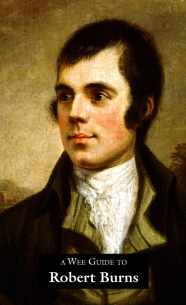Robert Burns 1786-88: Edinburgh Burns in Love
‘For my own part I never had the least thought or inclination of turning Poet until I got heartily in Love, and then Rhyme & Song were, in a manner, the spontaneous language of my heart.’
But Edinburgh was not a failure. An image had been stored in the popular imagination, and Edinburgh society fell in love with it – the ‘Heav’n-taught’ ploughman whose deceptively unsophisticated lyrics had a wide popular appeal, to servant and master – and mistress – alike.
The Edinburgh society to which Burns had access – not least because of his Freemasonry – was self-consciously elegant, fashionable and intellectual. Great men cast their shadow everywhere: David Hume, the philosopher and author of A Treatise of Human Nature, was but 10 years in his grave: Adam Smith had only just moved to London in search of a cure for his chronic bowel obstruction, undoubtedly the consequence of a life devoted to the study of political economy. Henry Dundas, Lord President of the Court of Session and the ‘uncrowned King of Scotland’, ruled Scotland in the name of the Prime Minister, William Pitt.
Burns bore Dundas a personal grudge: advised by a friend that it would make good sense to write a poem in praise of the great man, Rob did so. His innate pride and dignity did not make Rob a natural sycophant, and he seems to have accepted the need to lubricate his career path with such flatteries sourly.
In this instance, however, it backfired. Dundas completely ignored Rob’s poem and its covering letter and never bothered to reply. Hurt pride ensured that Burns never forgot the slight.
Of personal importance to Burns were his friendships with his hero, the novelist Henry Mackenzie – who largely orchestrated the Ploughman Poet myth – and the publisher William Creech. On 21 April 1787 Creech published what is known as the First Edinburgh Edition of Burns’ poems. Over-subscribed on publication, Creech had to reprint almost immediately. In all, 3000 copies were printed.
What was he like, this Ayrshire farmer without whom no gathering of the rich and famous was complete? Expecting a rough ploughman, whom did they really meet? Portraits of Burns suggest an open, candid face, too perpetually boyish to be handsome. He was of medium height and years at the plough had given him a slight stoop; exposure to the weather in all seasons made his complexion darker and coarser than was fashionable – the rich had pale, delicate skins upon which the wind never blew. Contemporary accounts describe Burns as being particular in his dress, whatever his financial circumstances; neat without being dandyish, he tied his black hair in a ponytail and never adopted the Edinburgh habit of using powder on it.
Two of Burns’ features were so striking that many who met him felt moved to comment on them. His eyes were large, dark and, according to the 15-year-old Walter Scott, glowing with life. ‘I never saw such another eye in a human head’, he wrote in boyish awe. Josiah Walker, an early biographer, wrote that ‘It [his eye] was full of mind’. And his speaking voice was, apparently, equally attractive: ‘melodic and expressive’. In her memoir of Burns, Maria Riddell wrote: ‘The rapid lightnings of his eye were always the harbingers of some flash of genius ... his voice alone could improve upon the magic of his eye ... it alternately captivated the ear with the melody of poetic numbers, the perspicuity of nervous reasoning, or the ardent sallies of enthusiastic patriotism.’
Although he was always somewhat accident-prone, he seems to have been a self-possessed and warmly attractive man who refused to play the part of the grateful recipient of Edinburgh’s graciousness. This did not please everyone. At a time when polite manners tended to be artificial as well as superficial, Burns’ steady gaze was unnerving. Even his sponsor, Henry Mackenzie described him as ‘a little too independent of his mind for his station’.
The women, too, were of a different sort – not servant girls and farmers’ daughters, and a million miles from Jean Armour. Women like Jane Duchess of Gordon, educated, witty and as free as only money and class could make them, impressed him mightily.
One woman of importance to Burns during this Edinburgh period – probably of great importance – was Peggy Chalmers, a farmer’s daughter and a distant relative of Burns’ friend Gavin Hamilton. They may have met early in 1787, when Burns was a newly published poet. They did meet again in Edinburgh, however, and Burns wrote the song ‘My Peggy’s Charms’ for her. In October that year, touring the Highlands, Burns spent eight days with Peggy at Harviestoun. He proposed marriage to her: she rejected him, but they remained on affectionate terms, and continued to write to each other until her marriage to an Edinburgh banker in 1788.
Burns’ feelings for her are expressed in one of these letters: ‘... When I think I have met with you, and have lived more of real life with you in eight days than I can do with almost anybody I meet with in eight years – when I think of the improbability of meeting you in this world again – I could sit down and cry like a child!’
With her ability to be both an intellectual companion as well as a physical one, Peggy’s refusal of his proposal may seem curious. This may in part have been because of her existing ‘understanding’ with Lewis Hay, whom she subsequently married: class may also have been an issue. Rob was a farmer whose wife needed to work in the dairy and the garden, and this practical role would have been out of the question for the cultivated Miss Chalmers.
Within weeks of his arrival in the capital, Burns had commenced a passionate friendship with one Agnes McLehose, a surgeon’s daughter and the niece of Lord Craig. The affair was largely conducted by letter and in correspondence the lovestruck couple became ‘Clarinda’ and ‘Sylvander’. In 1776 the 17-year-old Clarinda had married one James McLehose, a law agent, and by 1780 was the mother of four babies. It was an unhappy marriage, however,
and McLehose eventually deserted his wife for a black mistress and a plantation in Jamaica.
Agnes took a house in Potter Row, near the medical school in Edinburgh, and there established herself, with her uncle – a judge – as her social guardian and protector. Clarinda wrote poetry herself and was educated enough to take a critical view of Burns’ own poetry. She was immediately smitten by him at their first meeting in December 1787, and invited him to tea.
Burns was prevented from coming by an injury to his knee – a drunken coachman caused him to fall from a coach. Frustrated at not seeing each other, they began a rapid and eloquent exchange of letters. Their love was consummated in correspondence and not in fact: Agnes was, after all, married and a member of Edinburgh society mindful of her status and the expectations of her position. It was not only Clarinda’s married status that prevented a more conventional relationship, but social class as well – as was the problem with all the other educated, intelligent women Burns encountered in Edinburgh society. Intellectually he might be their superior, but socially he would always be their inferior – no more perhaps than a bit of celebrity rough. And he would never be allowed to forget that fact.
Initially at least, this lack of a physical dimension probably did nothing more than add a charge of excitement to the friendship between Burns and Clarinda. As the months passed, their letters became more and more passionate: ‘You are an angel, Clarinda ... to kiss your hand, to live on your smile ... I propose to keep sacred set times to wander in the woods and wilds for meditation on you.’
Emotionally wrapped up in a dream of love, Burns was not however the man to enjoy platonic relationships for long – and Clarinda sensed this. ‘I esteem you’, he wrote to Clarinda, ‘I love you as a friend ... I love you as a woman beyond any one in all the circle of creation’. This letter goes on in a similar vein of rapture for some time. Years later, against a copy of this letter, Burns was to write: ‘Fustian rant!’
He began to inhabit two Edinburghs: the drawing-rooms of the rich and famous, and the salty taverns of the Royal Mile and the Grassmarket, where he could be himself. The relationship between Sylvander and his Clarinda might be a communion of minds, but Rob Burns’ affairs with May Cameron and Jenny Clow, both servant girls, were emphatically not. Both women became pregnant, and both issued writs against Burns to ensure he acknowledged paternity.
His injured knee recovered, Burns took to the saddle for the first of the tours to other parts of Scotland that he made during this Edinburgh period. With his friend Robert Ainslie he visited the Border counties: East Lothian, Berwick, Roxburgh, Selkirk and Dumfries. They travelled east to west, and of course called in at Mossgiel and Mauchline, where Burns sought out Jean Armour. Jean’s honestly physical response to him must have seemed a refreshing change from the mannered eyelash-fluttering of Edinburgh.
Returning to the capital, Burns set out almost immediately for the north, starting from Linlithgow and Stirling. His companion this time was his friend ‘Kind honest-hearted Willie’ – William Nicol, master of classics at Edinburgh’s High School – though they had some fierce disagreements on their trip.
Throughout his life, Burns had the delightful habit of scratching spontaneous thoughts on window-panes with his diamond ring. Passing through Stirling and in an excess of fervour for the lost glamour of the Stewart kings, now replaced by a beef-witted German dynasty from Hanover, he wrote:
Stewarts once in glory reign’d’
And laws for Scotland’s weal ordained ...
A race outlandish fills their throne:
An idiot race, to honour lost –
Who know them best despise them most.
At this time, Burns was exploiting what influence he could to obtain what was virtually a civil service job, as an Exciseman – a collector of local taxation. Remembering by whom a civil servant is ultimately employed, Burns returned to Stirling a fortnight later and smashed the offending window. The travellers’ destination was Kincardine, where the Burns' family roots were, but in travelling back to the land of his forbearers, Burns was entertained in some style, staying at Blair Castle with the Duke and Duchess of Atholl, and Gordon Castle with the enigmatic Duchess Jane.
In 1788 Burns’ Edinburgh period came to an end. He had been feted and lionised, and hailed by the Freemasons as ‘Caledonia’s Bard’. He had made some money from his poems, but he needed a job – the growing brood of children for whom he took responsibility needed a more reliable source of income than poetry. Nor was he comfortable with the role of tame rustic which had been created for him: his pride rebelled against it. ‘How wretched is the man that hangs on and by the favours of the great!’ he wrote – and believed.
Early in that year he headed west again to deal with two urgent matters at home: the possibility of a new farm at Ellisland, and Jean Armour, heavily pregnant with the second set of twins which had been the legacy of their reunion the previous year.
Jean’s family had thrown her out: Mr Armour had undergone a change of heart and Burns’ fame, celebrity and – he thought – money now made him seem a more suitable son-in-law. During that brief return to Ayrshire in 1787 he had hoped to trap Burns into a formal marriage with Jean. The fact that she immediately gave herself to him and became pregnant again was the last straw. Feeling that her passionate response showed a lamentable lack of calculation and strategy, the Armours told her to leave their home. She was in a sad and desperate plight, and only Rob could save her – quite literally.
In Edinburgh, though, he had Clarinda. In December 1787 he had written to a friend: ‘Almighty Love still reigns and revels in my bosom; and I am at this moment ready to hang myself for a young Edinburgh widow’ – widow not being quite accurate.
In February, returning to Mossgiel to make arrangements for Jean’s confinement, he wrote to Bob Ainslie: ‘I found Jean ... destitute and friendless; all for the good old cause: I have reconciled her to her fate: I have reconciled her to her mother: I have taken her a room: I have taken her to my arms: I have given her a mahogany bed; I have given her a guinea; and I have f——d her till she rejoiced with joy unspeakable and full of glory ... But ... I swore her ... solemnly never to attempt any claim on me as a husband ... She did all this, like a good girl, and I took the opportunity of some dry horse-litter, and gave her such a thundering scalade that electrified the very marrow of her bones.’ Poor Jean! Somehow, yet again, Burns made it all seem entirely her fault, and bestowing on her the supreme gift of his body was supposed to make it all right.
On 3 March, Jean gave birth to twins: they both died.
Burns left for Edinburgh, and for Clarinda, again. But in March he was back in Mauchline, seeing to farm business and pursuing his hopes of an Excise career.
He wrote to Clarinda: ‘I ... called for a certain woman. I am disgusted with her! I cannot endure her! I .... tried to compare her with my Clarinda ...’ Burns concluded that it was like comparing a penny candle with the ‘cloudless glory of the meridian sun’. He went on to rail against Jean’s ‘vulgarity of soul’ and ‘tasteless insipidity’, saying that ‘I have done with her and she with me’.
Six weeks later, he had married Jean. He did not tell Clarinda, but left her to find out from his friend Robert Ainslie.
In a letter he crowed: ‘I am so enamoured with a certain girl’s twin-bearing merit that I have given her a legal right to the best blood in my body.’ As for Clarinda, busy at her desk in Edinburgh pouring out letter after letter of undying love and affection, the news of his marriage came second-hand. Burns himself did not write to her for a year. That body blow may be imagined – from the distance of 200 years, it has lost none of its hurt. The letter he wrote to her that year later is described as an essay in self-justification and contains nothing which suggests even a faint awareness of the pain he had caused her.
It has been suggested that Burns’ need for employment, and the offer from the Excise, lay behind his sudden change of heart over Jean: he was obliged to regularise his position. Marrying Jean may also have been a recognition of his need for honest physical affection set beside Clarinda’s arm’s-length letter writing. Whatever the truth may be, it is a cruel incident in the life of a man generally kind – but contradiction was ever the key to Burns’ character.
By 1790, Clarinda and Sylvander had resumed their correspondence and Burns was again writing to her as ‘my ever-beloved, my ever-sacred’. On 6 December 1791, five years before Burns’ death, they met in Edinburgh for the last time. This meeting led to the writing of ‘Ae Fond Kiss’, one of Burns’ finest lyrics.
‘Love,’ Burns wrote, ‘is the Alpha and Omega of human enjoyment.' Agnes McLehose seems to have understood him very well. She once told him, with great insight: ‘You are so formed you cannot be happy without a tender attachment’. Her use of the singular is the only incorrect note there. Having read Burns’ ‘autobiography’ – a letter written to Dr John Moore, and now in the British Museum – she commented that she could find ‘not a trace of friendship towards a female,’ adding that the long-suffering Jean Armour must be ‘either an angel or a dolt’.
Burns’ passion for Clarinda cooled, but she seems to have retained a place in her heart for him for ever, and became increasingly devout in old age. In 1831, some 40 years after Burns’ death, she wrote on the anniversary of their last meeting: ‘...this day I never can forget. Parted with Burns never more to meet in this world. Oh, may we meet in heaven.’
© Martin Coventry & Dilys Jones 2017









